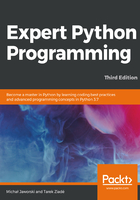
Implementation details
Sets in CPython are very similar to dictionaries. As a matter of fact, they are implemented like dictionaries with dummy values, where only keys are actual collection elements. Sets also exploit this lack of values in mapping for additional optimizations.
Thanks to this, sets allow very fast additions, deletions, and checks for element existence with the average time complexity equal to O(1). Still, since the implementation of sets in CPython relies on a similar hash table structure, the worst case complexity for these operations is still O(n), where n is the current size of a set.
Other implementation details also apply. The item to be included in a set must be hashable, and, if instances of user-defined classes in the set are hashed poorly, this will have a negative impact on their performance.
Despite their conceptual similarity to dictionaries, sets in Python 3.7 do not preserve the order of elements in specification, or as a detail of CPython implementation.
Let's take a look at the supplemental data types and containers.